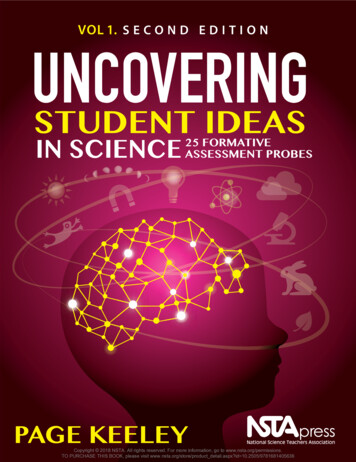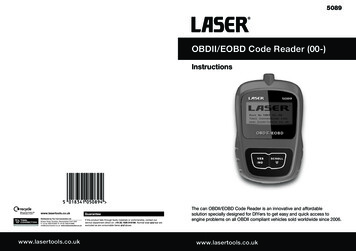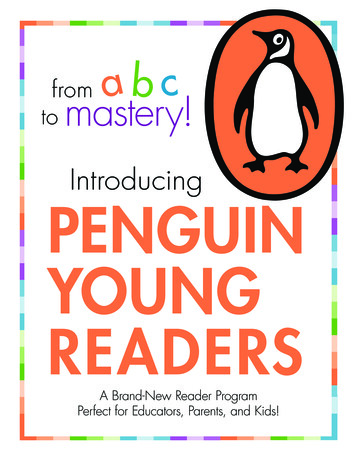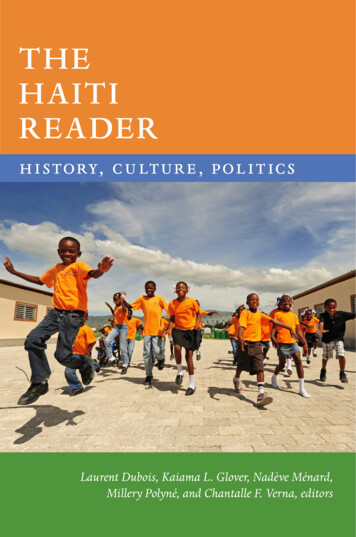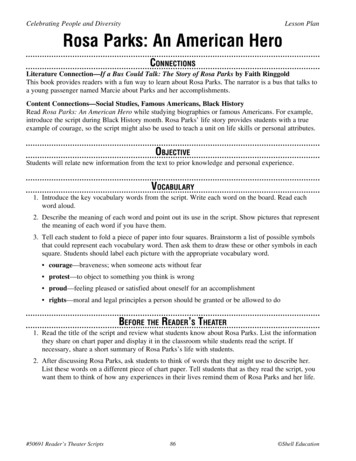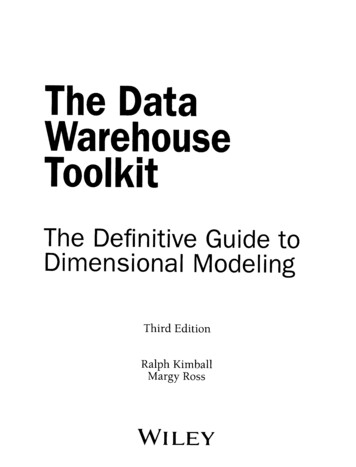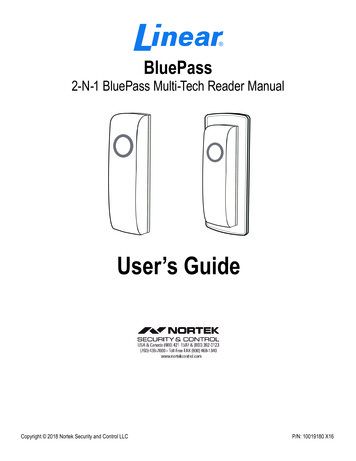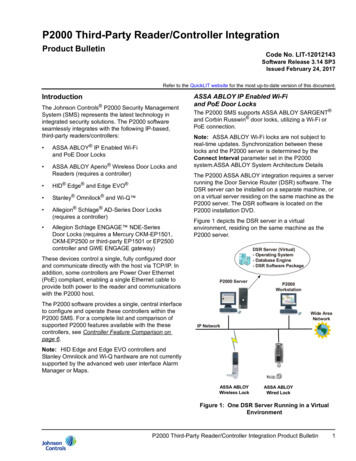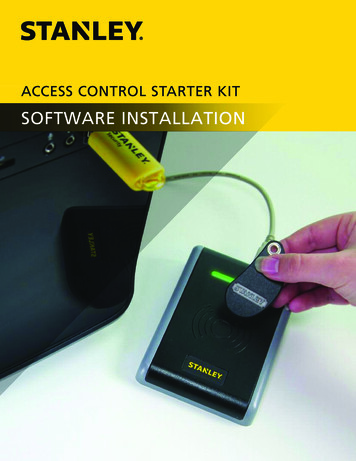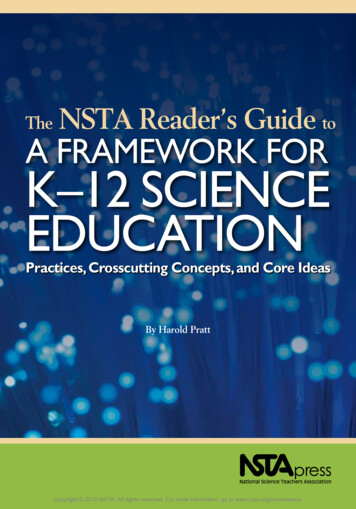
Transcription
TheNSTA Reader’s Guide toA Framework forK–12 ScienceEducationPractices, Crosscutting Concepts, and Core IdeasBy Harold PrattCopyright 2012 NSTA. All rights reserved. For more information, go to www.nsta.org/permissions.
Copyright 2012 NSTA. All rights reserved. For more information, go to www.nsta.org/permissions.
TheNSTA Reader’s Guide toA Framework forK–12 ScienceEducationPractices, Crosscutting Concepts, and Core IdeasBy Harold PrattArlington, VirginiaCopyright 2012 NSTA. All rights reserved. For more information, go to www.nsta.org/permissions.
ContentsBackground. 5Using This Guide. 6Executive Summary. 8PART I: A Vision for K–12 Science EducationChapter 1Introduction: A New Conceptual Framework. 9Chapter 2Guiding Assumptions and Organization of the Framework. 11PART II: Dimensions of the FrameworkChapter 3Dimension 1: Scientific and Engineering Practices. 13Chapter 4Dimension 2: Crosscutting Concepts. 16Chapter 5Dimension 3: Disciplinary Core Ideas: Physical Sciences. 17Chapter 6Dimension 3: Disciplinary Core Ideas: Life Sciences. 19Chapter 7Dimension 3: Disciplinary Core Ideas: Earth and Space Sciences. 21Chapter 8Dimension 3: Disciplinary Core Ideas: Engineering, Technology, andApplications of Science. 23PART III: Realizing the VisionChapter 9Integrating the Three Dimensions. 25Chapter 10Implementation: Curriculum, Instruction, Teacher Development, and Assessment. 27Chapter 11Equity and Diversity in Science and Engineering Education. 29Chapter 12Guidance for Standards Developers. 30Chapter 13Looking Toward the Future: Research and Development to Inform K–12 ScienceEducation Standards. 32References. 34National Science Teachers AssociationCopyright 2012 NSTA. All rights reserved. For more information, go to www.nsta.org/permissions.
BackgroundIn July 2011, the National Research Council (NRC) released A Framework for K–12 ScienceEducation: Practices, Crosscutting Concepts, and Core Ideas, which identifies key scientific ideasand practices all students should learn by the end of high school. The Framework serves as thefoundation for new K–12 science education standards that will replace those developed inthe 1990s, including National Science Education Standards (NSES) and Benchmarks for ScienceLiteracy (Benchmarks).A state-led effort to develop the new science standards—called Next Generation ScienceStandards (NGSS)—is under way. Managed by Achieve Inc., the process involves science experts,science teachers, and other science education partners. The first draft of the NGSS will not appearuntil sometime in 2012, and the final version most likely will not appear until late in the year.In the meantime, NSTA recommends that the science education community fully examine theFramework and explore in-depth the concepts and ideas on which the new standards will be built.Editor’s Note: The tables and page numbers referenced in this document refer to the prepublication copy of the Framework released in July 2011. A final print version will be releasedby the National Academies Press in late 2011 or early 2012 and will most likely have a differentpage numbering system. NSTA plans to update this Guide, including the page numbers, whenthe final Framework is printed. Check the NSTA website at www.nsta.org/ngss for updatedinformation.The NSTA Reader’s Guide to A Framework for K–12 Science EducationCopyright 2012 NSTA. All rights reserved. For more information, go to www.nsta.org/permissions.5
Using This GuideThis guide is intended for many audiences—including science teachers, science supervisors,curriculum developers, administrators, and other stakeholders in science education—to helpthem better understand and effectively implement the new standards when they are released.As the introduction to the Frameworkstates, “the framework is intended as aContents of the Frameworkguide to standards developers as wellas to curriculum designers, assessmentExecutive Summarydevelopers, state and district sciencePART I: A Vision for K–12 Science Educationadministrators, professionals responsible1 Introduction: A New Conceptual Frameworkfor science-teacher education, and sci2 Guiding Assumptions and Organization ofence educators working in informal setthe Frameworktings” (p. 1-1). Teachers play a key leadership role in each of these functions andPART II: Dimensions of the Frameworkwill benefit from a deep understanding3 Dimension 1: Scientific and Engineering Practicesof the Framework as a stand-alone document and as a guide to the use of the4 Dimension 2: Crosscutting Conceptsforthcoming NGSS.5 Dimension 3: Disciplinary Core Ideas: Physical SciencesTo make the best use of this guide,6 Dimension 3: Disciplinary Core Ideas: Life Sciencesthe reader should have a copy of the7 Dimension 3: Disciplinary Core Ideas: Earth andFramework in hand for reference. TheSpace SciencesFramework, and many other NRC8 Dimension 3: Disciplinary Core Ideas: Engineering,reports noted in this document, canTechnology, and Applications of Sciencebe downloaded free of charge from theNational Academies Press at www.nap.PART III: Realizing the Visionedu. This guide is designed to facilitate9 Integrating the Three Dimensionsthe study of the Framework, not replace10 Implementation: Curriculum, Instruction,Teacherreading it. For each chapter of theDevelopment, and AssessmentFramework, the guide provides11 Equity and Diversity in Science and EngineeringEducation12 Guidance for Standards Developers13 Looking Toward the Future: Research and Developmentto Inform K–12 Science Education StandardsAppendixesA Summary of Public Feedback and Subsequent RevisionsB References Consulted on Teaching and LearningC Biographical Sketches of Committee Members and StaffD Design Team Members61. an overview;2. an analysis of what is similarto and what is different fromprevious standards and benchmarks; and3. a suggested action for scienceteachers, science supervisors, andother science educators to supportunderstanding of the Frameworkand anticipate its impact on classrooms, schools, and districts.National Science Teachers AssociationCopyright 2012 NSTA. All rights reserved. For more information, go to www.nsta.org/permissions.
The overview is not intended to be an exhaustive summary of the Framework chapter,but rather a brief synopsis of the key idea(s). The second section—an analysis of what is newand different—is much more effective if the reader of this guide has a copy of the NSES andBenchmarks in hand or is reasonably familiar with these documents. Much of our analysisis based on comparisons with these two important documents that were published in themid-1990s. Other documents also will be referenced to provide additional background andreading. The third section—suggested action—contains recommendations for activities forindividuals, small teams, or larger groups to explore and learn about the ideas and conceptsin the Framework. While some will find the overview and analysis sections most insightful,others will appreciate the suggested actions and use them as guides for possible professionaldevelopment ideas.The NSTA Reader’s Guide to A Framework for K–12 Science EducationCopyright 2012 NSTA. All rights reserved. For more information, go to www.nsta.org/permissions.7
The Three Dimensionsof the Framework1. Scientific and Engineering Practices Asking questions (for science) and definingproblems (for engineering) Developing and using models Planning and carrying out investigations Analyzing and interpreting data Using mathematics and computational thinking Constructing explanations (for science) anddesigning solutions (for engineering) Engaging in argument from evidence Obtaining, evaluating, and communicatinginformation2. Crosscutting Concepts PatternsCause and effect: Mechanism and explanationScale, proportion, and quantitySystems and system modelsEnergy and matter: Flows, cycles, andconservation Structure and function Stability and change3. Disciplinary Core IdeasPhysical SciencesPS 1: Matter and its interactionsPS 2: Motion and stability: Forces and interactionsPS 3: EnergyPS 4: Waves and their applications intechnologies for information transferLife SciencesLS 1: From molecules to organisms: Structuresand processesLS 2: Ecosystems: Interactions, energy, and dynamicsLS 3: Heredity: Inheritance and variation of traitsLS 4: Biological evolution: Unity and diversityEarth and Space SciencesESS 1: Earth’s place in the universeESS 2: Earth’s systemsESS 3: Earth and human activityEngineering,Technology, and the Applications of ScienceETS 1: Engineering designETS 2: Links among engineering, technology,science, and societyExecutive SummaryThe executive summary states the purposeand overarching goal of the Framework:to “ensure that by the end of 12th grade,all students have some appreciation ofthe beauty and wonder of science; possesssufficient knowledge of science and engineering to engage in public discussionson related issues; are careful consumers ofscientific and technological informationrelated to their everyday lives; are able tocontinue to learn about science outsideschool; and have the skills to enter careersof their choice, including (but not limitedto) careers in science, engineering, andtechnology” (p. ES-1).The Framework recommends thatscience education be built around threemajor dimensions, which are provided inthe sidebar (Box ES.1, p. ES3)The intent is that the NGSS shouldintegrate these three dimensions. Theearly sections of the Framework do notcommunicate this intent, but it becomesclear in Chapter 9, “Integrating the ThreeDimensions,” and in the Chapter 12 recommendations to Achieve Inc. The earlychapters are instead designed to provide anunderstanding of each separate dimension.Source: NRC 2011, p. ES-38National Science Teachers AssociationCopyright 2012 NSTA. All rights reserved. For more information, go to www.nsta.org/permissions.
Part I:A Vision for K–12 Science EducationChapter 1Introduction: A New Conceptual FrameworkOverviewThe best description of the general vision of the Framework is provided on page 1-2:The framework is designed to help realize a vision for education in the sciences andengineering in which students, over multiple years of school, actively engage in science andengineering practices and apply crosscutting concepts to deepen their understanding of thecore ideas in these fields.The learning experiences provided for students should engage themwith fundamental questions about the world and with how scientists have investigated andfound answers to those questions.Throughout the K–12 grades, students should have theopportunity to carry out scientific investigations and engineering design projects related tothe disciplinary core ideas.By the end of the 12th grade, students should have gained sufficient knowledge ofthe practices, crosscutting concepts, and core ideas of science and engineering toengage in public discussions on science-related issues, to be critical consumers ofscientific information related to their everyday lives, and to continue to learn aboutscience throughout their lives.They should come to appreciate that science and thecurrent scientific understanding of the world are the result of many hundreds ofyears of creative human endeavor. It is especially important to note that the abovegoals are for all students, not just those who pursue careers in science, engineering, ortechnology or those who continue on to higher education.Also from the introduction (p. 1-2),The committee’s vision takes into account two major goals for K–12 science education:(1) educating all students in science and engineering and (2) providing the foundationalknowledge for those who will become the scientists, engineers, technologists, and techniciansof the future.The framework principally concerns itself with the first task—what all studentsshould know in preparation for their individual lives and for their roles as citizens in thistechnology-rich and scientifically complex world.The chapter discusses the rationale for including engineering and technology and for theexclusion of the social, behavioral, and economic sciences. It also includes a brief descriptionof how the Framework was developed by the NRC committee.AnalysisThe stated vision reinforces what has been well accepted as the vision for science education forthe past two decades and is clearly articulated in the NSES and Benchmarks.The NSTA Reader’s Guide to A Framework for K–12 Science EducationCopyright 2012 NSTA. All rights reserved. For more information, go to www.nsta.org/permissions.9
A major difference you will notice is that the Framework introduces and defines engineering and technology and outlines the reasons for their inclusion in the NGSS.What’s also new is that to achieve the goal, the Framework moves science education towarda more coherent vision by (1) building on “the notion of learning as a developmental progression”; (2) focusing “on a limited number of core ideas in science and engineering”; and (3)emphasizing “that learning about science and engineering involves integration of the knowledge of scientific explanations (i.e., content knowledge) and the practices needed to engage inscientific inquiry and engineering design” (p. 1-3).Suggested ActionCompare the Framework’s vision and overarching goals for science education tothose of your state, school, or district. What differences do you find? A review andpossible update by your curriculum committees might be in order because thenature of the vision and goals stated in the Framework will undoubtedly appear inthe NGSS. Note the increased emphasis on how students learn science in the meansor goals of how the vision will be achieved. This will be discussed in more detail inthe next chapter.10National Science Teachers AssociationCopyright 2012 NSTA. All rights reserved. For more information, go to www.nsta.org/permissions.
Chapter 2Guiding Assumptions and Organizationof the FrameworkOverviewThe Framework defines several guiding principles about the nature of learning science thatunderlie the structure and content of the Framework. Below is a summary of these principles,adapted from pages 2-1 through 2-4.Children are born investigators: In the early years of life, children engage in and developtheir own ideas about the physical, biological, and social worlds and how they work and, thus,can engage in scientific and engineering practices beginning in the early grades.Focusing on core ideas and practices: The Framework is focused on a limited set of coreideas to allow for deep exploration of important concepts and time for students to developmeaningful understanding of these concepts through practice and reflection. The core ideasare an organizing structure to support acquiring new knowledge over time and to help studentsbuild capacity to develop a more flexible and coherent understanding of science.Understanding develops over time: Student understanding of scientific ideas maturesover time—across years rather than in weeks or months—and instructional supports and experiences are needed to sustain students’ progress.Science and engineering require both knowledge and practice: Science is not just abody of knowledge that reflects current understanding of the world; it is also a set of practicesused to establish, extend, and refine that knowledge. Both elements—knowledge and practice—are essential.Connecting to students’ interests and experiences: For students to develop a sustainedattraction to science and for them to appreciate the many ways in which it is pertinent totheir daily lives, classroom learning experiences in science need to connect with students’ owninterests and experiences.Promoting equity: All students should be provided with equitable opportunities to learnscience and become engaged in science and engineering practices—with access to qualityspace, equipment, and teachers to support and motivate that learning and engagement, andwith adequate time spent on science.The balance of the chapter outlines the structure of the Framework and its three dimensions—scientific and engineering practices, crosscutting concepts, and disciplinary coreideas—and their progressions across grades K–12.AnalysisThe introduction to this chapter lists the NRC publications Taking Science to School (Duschl,Schweingruber, and Shouse 2007), America’s Lab Report (Singer, Hilton, and Schweingruber2006), Learning Science in Informal Environments (Bell et al. 2009), Systems for State ScienceAssessments (Wilson and Bertenthal 2006), and Engineering in K–12 Education (Katehi, Pearson,The NSTA Reader’s Guide to A Framework for K–12 Science EducationCopyright 2012 NSTA. All rights reserved. For more information, go to www.nsta.org/permissions.11
and Feders 2009) that served as background for the writers of the Framework. These reportsare based on research from the 15 years following the publication of the NSES and Benchmarksand represents an evolving knowledge of how students learn science and the nature of curriculum and instruction that will facilitate the learning. That increased level of knowledge abouthow students learn is reflected in the guiding principles outlined above.Suggested ActionObtain copies of the publications cited in this chapter and form study or discussiongroups to become familiar with the research synthesized in them and their view ofhow students learn science. Explore how the research and ideas have changed sincethe publication of the NSES and Benchmarks and how they are reflected in theFramework. One of the best places to begin is with How People Learn: Brain, Mind,Experience, and School (Bransford, Brown, and Cocking 2000). This seminal workis easy to read, contains research on the broad topic of how learning occurs, and hasa chapter with examples on how students learn science, mathematics, and history.In addition, a recent report that has had significant influence on the Framework isTaking Science to School (Duschl, Schweingruber, and Shouse 2007). This reportprovides the background for the Framework’s guiding principles and helps explainthe evolution from the language of inquiry to practices.12National Science Teachers AssociationCopyright 2012 NSTA. All rights reserved. For more information, go to www.nsta.org/permissions.
Part II:Dimensions of the FrameworkChapter 3Dimension 1: Scientific and Engineering PracticesOverviewThis chapter continues and strengthens one of the principal goals of science education, “toengage in scientific inquiry” and “reason in a scientific context” (p. 3-1). In doing so, it explainsthe transition or evolution from inquiry to practices and discusses the reasons why practices areconsidered to be an improvement over the previous approaches.The change is described as an improvement in three ways: “It minimizes the tendency to reduce scientific practice to a single set of procedures”(p. 3-2).By emphasizing the plural practices, it avoids the mistaken idea that there is onescientific method.It provides a clearer definition of the elements of inquiry than previously offered.Scientific and Engineering PracticesAsking Questions and Defining ProblemsA basic practice of the scientist is the ability toformulate empirically answerable questions aboutphenomena to establish what is already known,and to determine what questions have yet to besatisfactorily answered.Engineering begins with a problem that needs tobe solved, such as “How can we reduce the nation’sdependence on fossil fuels?” or “What can be doneto reduce a particular disease?” or “How can weimprove the fuel efficiency of automobiles?”Developing and Using ModelsScience often involves the construction anduse of models and simulations to help developexplanations about natural phenomena.Engineering makes use of models and simulationsto analyze systems to identify flaws that might occuror to test possible solutions to a new problem.Planning and Carrying Out InvestigationsA major practice of scientists is planning andcarrying out systematic scientific investigationsthat require identifying variables and clarifyingwhat counts as data.Engineering investigations are conducted to gaindata essential for specifying criteria or parametersand to test proposed designs.Analyzing and Interpreting DataScientific investigations produce data that mustbe analyzed to derive meaning. Scientists use arange of tools to identify significant features andpatterns in the data.Engineering investigations include analysis ofdata collected in the tests of designs. This allowscomparison of different solutions and determineshow well each meets specific design criteria.The NSTA Reader’s Guide to A Framework for K–12 Science EducationCopyright 2012 NSTA. All rights reserved. For more information, go to www.nsta.org/permissions.13
Using Mathematics, Information and Computer Technology, and Computational ThinkingIn science, mathematics and computation arefundamental tools for representing physicalvariables and their relationships.In engineering, mathematical and computationalrepresentations of established relationships andprinciples are an integral part of the design process.Constructing Explanations and Designing SolutionsThe goal of science is the construction oftheories that provide explanatory accounts of thematerial world.The goal of engineering design is a systematicapproach to solving engineering problems that isbased on scientific knowledge and models of thematerial world.Engaging in Argument From EvidenceIn science, reasoning and argument are essentialfor clarifying strengths and weaknesses of a line ofevidence and for identifying the best explanationfor a natural phenomenon.In engineering, reasoning and argument areessential for finding the best solution to aproblem. Engineers collaborate with their peersthroughout the design process.Obtaining, Evaluating, and Communicating InformationScience cannot advance if scientists are unableto communicate their findings clearly andpersuasively or learn about the findings of others.Engineering cannot produce new or improvedtechnologies if the advantages of their designs arenot communicated clearly and persuasively.The Framework identifies eight practices that are essential elements of a K–12 science andengineering curriculum and describes the competencies for each practice. They are identifiedand described in “Scientific and Engineering Practices” above.For each practice, the Framework includes a comparison of how the practice is seen in scienceand engineering, a list of student goals to achieve by grade 12, and a discussion of the progressionto reach those goals from the early grades through grade 12. Box 3-2 (p. 3-29), “DistinguishingPractices in Science From Those in Engineering,” provides a very useful three-page table.The Framework repeatedly emphasizes that practices are not taught in isolation but are anessential part of content instruction. Consider this quote from page ES-1 (emphasis added):“the committee concludes that K–12 science and engineering education should focus on a limited number of disciplinary core ideas and crosscutting concepts, be designed so that studentscontinually build on and revise their knowledge and abilities over multiple years, and supportthe integration of such knowledge and abilities with the practices needed to engage in scientificinquiry and engineering design.”AnalysisThe notion of moving from the language of inquiry to that of practices, and the inclusionof engineering practices, will most likely require an adjustment or paradigm shift for manyscience educators. For the experienced teacher or science educator who is familiar with theinquiry standards in NSES and has helped students meet them through the use of “inquiries,”the practices will not seem that foreign. The added details and explanations of the practices willbe an advantage to many users.14National Science Teachers AssociationCopyright 2012 NSTA. All rights reserved. For more information, go to www.nsta.org/permissions.
The parallel discussion of each practice in both science and engineering does not implythat the two should be taught or learned at the same time, but rather intends to point out thesimilarities and differences among the practices in both disciplines. In some sense, the sciencepractices have emerged from Taking Science to School (Duschl, Schweingruber, and Shouse2007) and Ready, Set, Science! (Michaels, Shouse, and Schweingruber 2008), both of whichprovide a review of the research on how students learn science and how that can be used inthe creation of teaching materials and classroom instruction. The Framework builds on thisresearch and has identified engineering practices as a parallel discussion.In past years, science practices have not received the same emphasis that has been placed oncontent knowledge, nor has the integration of content and inquiry been achieved to any greatextent. The NGSS most certainly will include an equal and integrated emphasis. Consider thisquote from page 2-3: “Science is not just a body of knowledge that reflects current understanding of the world; it is also a set of practices used to establish, extend, and refine that knowledge.Both elements—knowledge and practice—are essential.” The integration of practices with thecontent will improve students’ understanding of the concepts and purposes of science and willavoid the teaching and learning of the competencies of inquiry in isolation.Suggested ActionThe shift for most science educators in this area will be the movement from thelanguage and standards of inquiry in the NSES to the language of practices andbecoming familiar with the engineering practices. To gain a better understandingof engineering, obtain Engineering in K–12 Education: Understanding the Status andImproving the Prospects (Katehi, Pearson, and Feders 2009) and Standards for K–12Engineering Education? (NRC 2010b), two of the many documents referenced atthe end of this Framework chapter, and use them as resources for study and discussion. Both can be downloaded for free from the National Academies Press at www.nap.edu.Compare the practices of inquiry in your instruction, instructional materials,and assessment to those in the Framework to see what may need to be added orspelled out in more detail. Notice the progression of the goals for each practice.Check your grade level for the practices against those in the Framework. To whatextent are they integrated with the content in your curriculum? Since the NGSSwill integrate the three dimensions (see Chapter 9), beginning to review how practices of inquiry are integrated in your existing instruction—as well as how theyare aligned and progress from level to level—will enhance your ability to use theanticipated new standards.The NSTA Reader’s Guide to A Framework for K–12 Science EducationCopyright 2012 NSTA. All rights reserved. For more information, go to www.nsta.org/permissions.15
Chapter 4Dimension 2: Crosscutting ConceptsOverviewThis chapter outlines the second dimension of the Framework, seven crosscutting concepts thathave great value across the sciences and in engineering and that are considered fundamental tounderstanding these disciplines:1. Patterns2. Cause and Effect: Mechanism and Explanation3. Scale, Proportion, and Quantity4. Systems and System Models5. Energy and Matter: Flows, Cycles, and Conservation6. Structure and Function7. Stability and ChangeAnalysisReaders familiar with the NSES and Benchmarks will recognize that the Framework’s crosscutting concepts are similar to those in the Unifying Concepts and Processes in NSES and theCommon Themes in Benchmarks. Although the previous documents call for the integration ofthese concepts with the content standards, the Framework specifically recommends, “Standardsshould emphasize all three dimensions articulated in the framework.” (See Recommendation4 in Chapter 12, p. 12-3.) This requirement will not only be a challenge to the writers of theNGSS but will also call for a major change in instructional materials and assessments.Suggested ActionParticipate in a review to determine if and how the Unifying Concepts and Processesin NSES and/or the Common Themes in Benchmarks are currently incorporated inyour standards, curriculum, and instructional materials.The list of crosscutting concepts in the NGSS will undoubtedly use the list inthe Framework, making it possible to begin planning professional development toassist teachers in understanding and incorporating the concepts into their currentteaching without waiting for the completion of the NGSS. The above review couldserve as the impetus and needs assessment for the initiation and planning of theprofessional development. Exemplary ins
the nStA reader’s Guide to A Framework for K–12 Science Education 5 Background In July 2011, the National Research Council (NRC) released A Framework for K–12 Science Education: Practices, Crosscutting Concepts, and Core Ideas, whichidentifies key scientific ideas and pract
